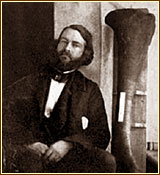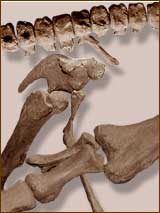In October, 1858, a crew of local diggers led by Philadelphia Academy of Natural Sciences member William Foulke excavated the nearly-complete skeleton of a gigantic prehistoric animal

|
|
Academy of Natural Sciences |
|
|
An 1858 photograph of Dr. Joseph Leidy and one of the giant Hadrosaurus bones excavated from a marl pit near Maple Avenue in Haddonfield.
|
|
from a marl pit on the Haddonfield farm of John Estaugh Hopkins. Incredibly, the mysterious creature had the anatomical features of both a lizard and a bird.
Foulke summoned Dr. Joseph Leidy to the scene to oversee the removal, preservation and interpretation of the fossilized remains. Leidy, a professor of anatomy and chairman of the Board of Curators of Philadelphia's Academy of Natural Sciences, was a leading expert in the emerging science of fossil studies. He quickly recognized that the animal was a dinosaur and that the find was an epochal scientific event.
World's first
On December 14, 1858, at a formal meeting of Academy members, Dr. Leidy became the world's first scientist to present a paper describing the factual anatomy of a dinosaur -- the animal he named Hadrosaurus foulkii.
For more than a century prior to that, many people throughout Europe and North America had found fossilized pieces of ancient, unknown animals. But these invidiual bones and teeth had been just that -- single, isolated items that offered only tantalizing clues about the size, shape and nature of the animals they had come from.
In 1841, London Victorian scholar Richard Owen studied a number of collections of such random fossilized remains and concluded they came from a family of large reptile-like animals that had gone completely extinct. He called his speculative animals by the Greek words for "terrible lizards": Dino Saurs.
Seized the imagination
At the same time it seized the imagination

|
|
Photo: Hoag Levins |
|
|
The set of bones dug from the Maple Avenue site in 1858 allowed scientists to document and study the exact details of dinosaur anatomy.
|
|
of scientists and laymen alike, Owen's 1841 concept -- that the earth may have once been inhabited by gargantuan creatures dramatically different from any known to living man -- was wildly controversial. And it remained so for for another 17 years.
The 1858 discovery of the nearly complete skeleton of Hadrosaurus foulkii and its documentation by Dr. Leidy provided irrefutable physical proof that dinosaurs had been real. And the actual bones showed that the anatomy of dinosaurs had, indeed, been as fantastically different from modern animals as Owens had predicted.
After their excavation, the bones of the Haddonfield Hadrosaurus were taken to the Academy of Natural Sciences where they have remained ever since.
The find, which ultimately catapulted Dr. Leidy to fame as the father of North American vertebrate paleontology, also made Haddonfield famous as the place where dinosaur paleontology became a credible modern science. -- Hoag Levins
|







